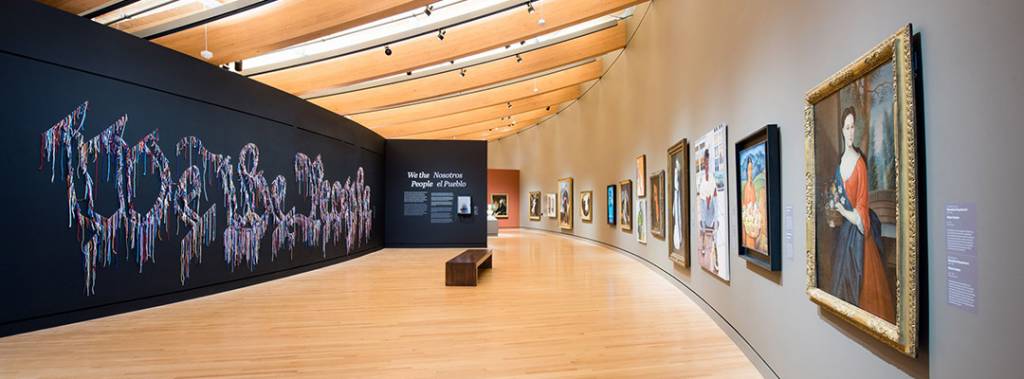Crystal Bridges Museum of American Art previews its redesigned Early American Art Galleries, which have been closed since January while updates were underway. The newly designed permanent collection spaces will open on March 16, marking the first reinstallation for the galleries since the museum opened in 2011.
“Two years ago, Crystal Bridges began conversations with our community and peers about making our galleries more inclusive and engaging” said Rod Bigelow, Crystal Bridges Executive Director and Chief Diversity & Inclusion Officer. “We’re excited to share these renovated and reinstalled spaces that better reflect the complexity of the American story—and we look forward to ongoing dialogue and discoveries as new connections with historic American art are revealed.”
The Early American Art Galleries will feature 185 objects, primarily from the museum’s permanent collection, including many works that will be on view for the first-time -as well as familiar favorites, interspersed with more than 25 loans from around the country. Information will be presented in both Spanish and English, as well as through new digital experiences.
“In these galleries, works reflect the beauty, complexity, and contradiction that comprise American art and stories both past and present. To better represent multiple perspectives and experiences, we’ve borrowed Native American art, folk art, and Spanish Colonial art from other museums and private collections,” said Crystal Bridges Curator Mindy Besaw. “In addition, we’re including artwork and objects that offer a few surprises along the way—helping visitors to see their favorites in a new light and reconsider American art and experience.”
Upon entering the gallery, visitors will be warmly welcomed by Nari Ward’s We the People (2015), a 28-foot installation with the first three words of the preamble to the U.S. Constitution constructed in shoelaces. This work, along with portraits from all time periods, and representing varied artist’s backgrounds, sets the tone for the galleries and highlights the diversity that has always been present in American culture, while illuminating the ongoing struggle for inclusion. The portraits include Charles Willson Peale’s George Washington, in conversation with a Mississippian figure from ca. 1450-1650, made in Arkansas. The figure, on loan from the University of Arkansas Museum Collections, expands the traditional storyline of American history, encouraging visitors to reflect on a time before Europeans settled the continent.
Following this introduction, the reinstallation unfolds chronologically through three different time periods and thematic groupings. The first, Networks and Power explores the formation of the visual identity during early nation building. The addition of Spanish Colonial painting (including a rare portrait from colonial Cuba on loan from the Denver Art Museum) and American folk art provide a more nuanced look at the way art reflects and shapes nations and communities.
People on the Move reflects on the mid-nineteenth century and the extraordinary social transformation taking place as Americans moved from farms to cities and new transportation systems, such as steamships, trains, and bicycles, changed the pace of daily life. Object descriptions will point out the ways paintings from this time period contained hidden meanings for their contemporary audiences.
The last section, Painters of Modern Life, focuses on art related to emerging modern life, including themes of labor and leisure. Contemporary sculpture and painting playfully inserted in the installation draws attention to the fast-paced changes in art and life continued throughout the twentieth century. At the conclusion of the Early American Art galleries, a dramatic installation of over 40 works are hung in the Paris Salon style, where artworks were installed tightly together, allowing for more art to be on view. This salon-hang display, addresses notions of beauty and artistic style toward the end of the nineteenth and the beginning of the twentieth centuries.
“This installation is meant to be dynamic and experimental,” said Bigelow. “We’re excited about the flexibility of these spaces and the opportunity to change artworks over time. We hope that the reinstalled galleries will increase access to more art, encourage broader perspectives, and facilitate unexpected learning moments.”
A focused exhibition space within the first Early American Art Gallery will feature rotating artworks twice a year, opening with How Do You Figure? on view March 16 through August 20, 2018. The works in this exhibition are from the permanent collection and span the 1700s to today, offering a variety of approaches, styles, and media for depicting the human body. The examples are rich and varied, from fully finished paintings to preliminary sketches and feature many artworks on view for the first time. Comprised of 35 works, the exhibition offers visitors a chance to explore the complexities of process and anatomy.
Near the focused exhibition gallery is a small, 105-foot-area that has been transformed into a space for experimentation. The Niche will feature behind-the-scenes information, projects, and a testing ground for new ideas. The rotation schedule will be frequent, with projects lasting a few days up to a month. For the debut, viewers will get insight into the designer’s process for choosing paint colors in the gallery.
Additionally, the reopened galleries will feature:
- All text presented in both Spanish and English
- Extended digital labels and touchscreen table
- Artmaking activities for all ages
- New audio content available through the updated Crystal Bridges App
- NEW Crystal Bridges Virtual Reality (CBVR) which offers an immersive experience with the art collection, museum, and grounds. While a collection favorite, the painting Kindred Spirits by Asher B. Durand, is on loan to the Metropolitan Museum of Art, visitors can journey into this Hudson River Valley landscape through virtual reality technology, available online.
- Visit the newly launched Crystal Bridges’ Google Arts & Culture page to experience the museum with 360 tours of the galleries and grounds.
- Admissions to the museum’s permanent collection is always free, sponsored by Walmart.




